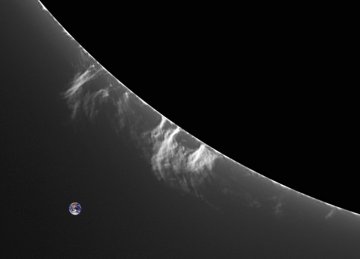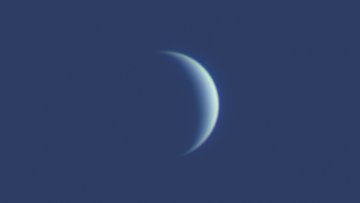 Where's Saturn? Is that a UFO--or the ISS? What's the name of that star? Get the answers from mySKY--a fun new astronomy helper from Meade. Where's Saturn? Is that a UFO--or the ISS? What's the name of that star? Get the answers from mySKY--a fun new astronomy helper from Meade. CANADIAN METEOR: On July 17th, astronomer Marjorie Dessureault of Quebec's Observatoire du Cégep de Trois-Rivières witnessed a "huge meteor passing through Bootes and the Big Dipper. It was was brighter than a full moon." Sky watchers, if you saw the same meteor, please contact Marjorie with details. She hopes to gather enough data to calculate its trajectory and possible landing site. PROMINENCE ALERT: "The southeastern limb of the sun is still burning," reports Cai-Uso Wohler of Bispingen, Germany. This picture, which he took just hours ago using a Coronado SolarMax60, shows titanic "flames" many times taller than Earth itself: 
In fact, as Wohler knows, no combustion is involved. Prominences are clouds of hydrogen held aloft by solar magnetic fields. They glow simply because they are hot (you would be hot, too, if you were so close to the surface of a star), not because of any exothermic chemical reaction involving oxygen. Nevertheless, the resemblence to fire can be compelling, as shown in this movie recorded earlier today by Pavol Rapavy of Rimavska Sobota, Slovakia. more images: from Pete Lawrence of Selsey, West Sussex, UK; from Emiel Veldhuis and Guan Nuyen of Zwolle, the Netherlands. CRESCENT PLANET: Like the Moon, Venus has phases, and at the moment it is a beautifully-slender crescent. Pete Lawrence of Selsey, UK, took this picture through his 14-inch telescope on July 17th: 
Why is the sky around Venus blue? Because he took the picture in broad daylight. "Venus is like a sparkling jewel in the daytime sky," Lawrence says. The trick is finding it. "On July 17th around three o'clock in the afternoon, the Moon was quite close to Venus: image. The Moon was straightforward to see with the naked eye and it was the perfect guide to the brilliant planet." Of course, daylight is not required. Venus is even easier to find at sunset when it hangs low in the darkening western sky. Set up your telescope and take a look: sky map. more images: from Wah! of the Hong Kong Astrofarm; from Sadegh Ghomizadeh of Tehran, Iran; from Will Gater of South Devon, UK.
.2007 Noctilucent Cloud Gallery
[Night-Sky Cameras] ["Noctilucent Cloud"--the song] | 
